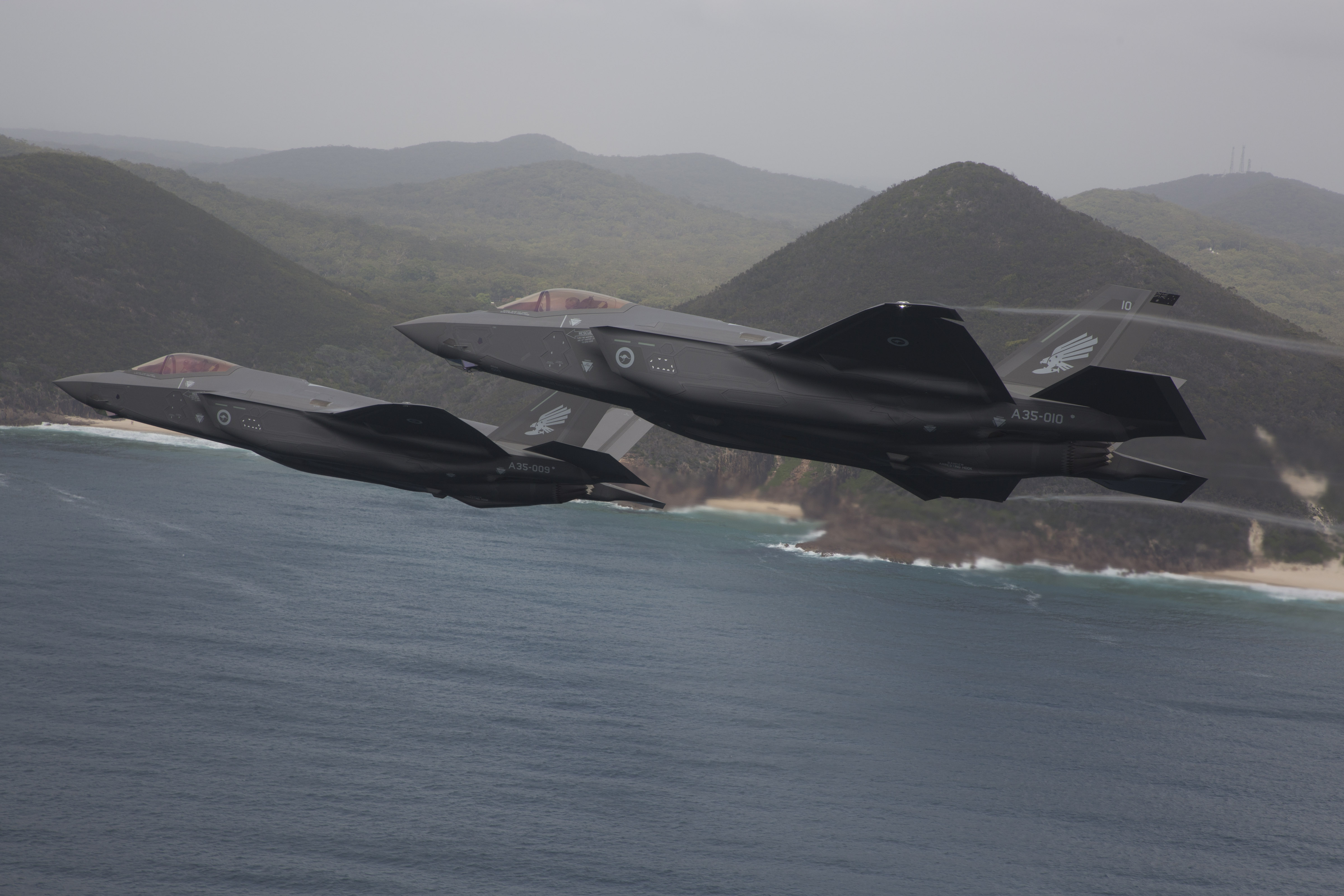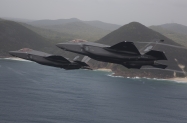F-35A Lightning II Joint Strike Fighter Arrives in Australia

All imagery © Commonwealth of Australia, Department of Defence (unless otherwise credited)
On 10 December 2018, a new technological era dawned as Air Force celebrated the delivery of its first F-35A Joint Strike Fighter aircraft at RAAF Base Williamtown, NSW. Royal Australian Air Force officer, Wing Commander Darren Clare, Commanding Officer of No. 3 Squadron, Joined Government, Departmental and Air Force representatives at the arrival ceremony of the first two F-35A aircraft at RAAF Base Williamtown. Senior dignitaries attending: The Minister for Defence, the Hon Christopher Pyne MP, accompanied by the Governor General of the Commonwealth of Australia, His Excellency General Sir Peter Cosgrove AK MC (retd), Chief of Defence Force, General Angus Campbell AO DSC, and Chief of Air Force, Air Marshal Gavin Davies, AO, CSC. The first two F-35s in 3 Squadron markings were escorted up the coast by F/A-18s representing Number 2 Operational Conversion Unit (F/A-18B “Tub”), Nos 75 and 77Squadrons (F/A-18A HUG with special tails) and 77SQN- marked B-model photo-ship.

Chief of Air Force, Air Marshal Gavin Davies, AO, CSC and Wing Commander Darren Clare, Commanding Officer of No. 3 Squadron at the arrival ceremony at RAAF Base Williamstown.
Photorecon thanks the contributors who have provided us with some amazing images of the arrival from a number of vantage points.
The Australian Defence Force (ADF) was proud to showcase the first two F35A Joint Strike Fighter aircraft of the Royal Australian Air Force Fleet. Royal Australian Air Force pilots and maintenance personnel are embedded within United States Air Force units and partnering with Lockheed Martin in preparation for the introduction of Australia’s first fifth-generation air combat capability. A briefing on the F-35A capability acquisition follows:

As No. 3 Squadron begins verifying and validating the F-35 capability in the Australian operating environment, Head Joint Strike Fighter Air Vice-Marshal (AVM) Leigh Gordon reflects on two decades of dedication and innovation that have positioned Air Force as one of the most advanced in the world.
The global F-35 Program will deliver a transformational air combat capability that will enable the ADF to prevail against lethal enemies well into the 21st Century – but delivering a capability as complex as the F-35A Joint Strike Fighter (JSF) takes time.

“Twenty years ago, Project AIR6000 was established to consider the ‘whole of capability’ options to replace the ageing F/A-18A/B Classic Hornet and F-111 fleets,” AVM Gordon said. “In June 2002, Australia joined the System Development and Demonstration phase of the global F-35 Program to gain insight into the aircraft’s development and capabilities.”
First Pass approval of Project AIR6000 and approval to enter the Production, Sustainment and Follow-on Development (PSFD) phase of the F-35 Program occurred in 2006. “Joining the PSFD phase provided Australia with visibility of, and some influence over, development of the F-35 Program – but with no commitment to buy aircraft,” AVM Gordon said. “This was important because Australia had not finalised its decision to acquire the F-35.”

After rigorous assessment, the F-35A JSF was determined to be the most advanced, affordable fifth-generation multi-role stealth fighter to meet Australia’s needs. Second Pass approval in November 2009 authorised Defence to manage a staged approach to acquisition, with Stage 1 to procure an initial 14 aircraft and enabling elements to commence training.
In April 2014, the Government approved Project AIR6000 Phase 2A/B Stage 2, authorising Defence to purchase an additional 58 aircraft, facilities and support systems required to deliver Initial Operating Capability (IOC) in 2020 and Final Operating Capability (FOC) in 2023. This brought the total order for Australian F-35A JSF aircraft to 72,” AVM Gordon said. A few months later, Defence celebrated as the first two Australian F-35A JSF aircraft rolled off Lockheed Martin’s production line in Fort Worth, Texas. These aircraft were later ferried to the international Pilot Training Centre at Luke Air Force Base in Arizona to be used in a pool of international training aircraft.
In March 2017 Photorecon reported on an F-35 project update featuring Lieutenant General Chris Bogdan, Program Executive Officer – F-35 Lightning II Program and Air Vice-Marshal Leigh Gordon, Head, JSF Division – Australia. The background to this briefing was the first two RAAF F-35As were released from service at Luke AFB (where they are part of the International Pilot Training Centre), to attend the Australian International Airshow at Avalon Airport, Geelong Victoria – having ferried via Hawaii, Guam and Amberley. These first two early-production Australian airframes, A35-001 (AU-1) and A35-002 (AU-2) appeared before the Australian taxpayer for the very first time piloted by Wing Commander Andrew Jackson and Squadron Leader David Bell – the first Australian pilots to qualify on the JSF and performed brief passes and impressive breaks over the crowd during the Friday trade day. Prime Minister Malcolm Turnbull, Defence Minister Senator Marise Payne and Defence Industry Minister Christopher Pyne joined CAF to welcome the pilots to Avalon….

When people think of the JSF they envisage an impressive piece of machinery – and it undoubtedly is. But what makes the JSF capability so transformational are the background systems and infrastructure that support it. Essential infrastructure work began at RAAF Base Williamtown in May 2015, representing almost AU$1 billion of the facilities investment in the Australian F-35A Project. “Much of this work is now complete and ready to support JSF operations in Australia,” AVM Gordon said.
“A critical part of this effort was building the Off-Board Information Systems Centre (OBISC), which officially opened in July 2017. The OBISC is unique to Australia and is being observed with interest by other Partner Nations as it allows a safe environment in which to introduce and test Autonomic Logistics Information System (ALIS) upgrades and to develop procedures for ALIS in-service. “ALIS is critical to successful Australian JSF operations as it provides the essential off-board information system infrastructure (hardware, software and data) that performs maintenance management, fault diagnostics, supply support, mission planning, and training management across the F-35A weapon system.”
Throughout 2018, Australia’s eight Low Rate Initial Production Lot 10 aircraft were accepted by Air Force and began flying operations at Luke Air Force Base. “These aircraft have Block 3F mission system software installed, which delivers the next increment of war-fighting capability and is the requirement for the Australian IOC declaration,” AVM Gordon said. “This was a significant milestone for the Australian F-35A Project, demonstrating the maturity of the US-led global F-35 Program.”

Royal Australian Air Force officer Wing Commander Darren Clare, Commanding Officer of No. 3 Squadron, at the arrival ceremony of the first two F-35A aircraft at RAAF Base Williamtown.
While the arrival of our first F-35A JSF aircraft at Williamtown marks the official beginning of JSF operations in Australia, the Project AIR6000 journey does not end as aircraft touch down on Australian flightlines. AVM Gordon said Air Force would now verify and validate the Australian F-35A air system, while the “JSF Division would continue to deliver the capability until all 72 aircraft are operating in Australia and FOC is declared at the end of 2023”. “The Australian F-35A Project has seen its fair share of challenges,” he said, “but that is to be expected in such a complex acquisition program. I am proud of the people who have worked hard over the past 20 years to deliver this capability for Australia.”

Photorecon thanks the Australian Government – Department of Defence for providing background information for this note.













































